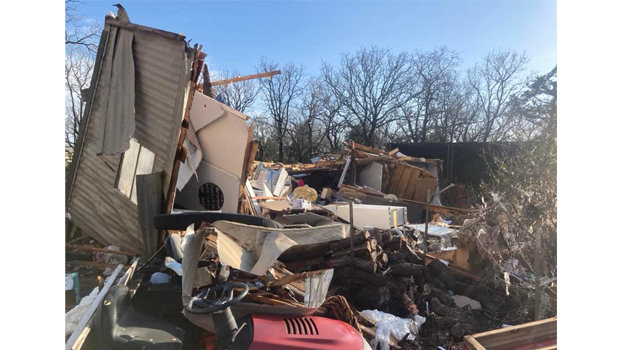NEWS
March record month for tornadoes across the southern states

By Adriana Navarro,
AccuWeather staff writer
The month of March across the contiguous United States ended as it began: stormy. As the seasons clashed and spring fought to overtake winter, the tumultuous pattern sparked numerous severe weather events across the nation. When the final tally is in, March 2022 very well could set a record for the most tornadoes ever in the month of March across the U.S. since record-keeping began.
AccuWeather forecasters say global warming could be one factor behind the exceptional number of tornadoes in March.
Montague County was the site of three separate EF-1 tornadoes on March 21 which caused major damage across the area.
At least 253 preliminary tornado reports were recorded throughout March 2022, according to the latest count from the Storm Prediction Center. While the number is preliminary, only 193 of the reports need to be confirmed as actual tornadoes to break the record of 192 confirmed tornadoes in 2017, according to the National Climatic Data Center. Records date back to 1950, though the numbers for 2020 through 2022 are preliminary.
The devastating storms that charged through the Midwest on the weekend of March 5, claiming the lives of at least seven people, served as a precursor to what the rest of the month would look like. It was during this storm that an EF4 tornado spawned, tearing through Winterset, Iowa, and killing six people, including four members of one family. This was also the storm during which the National Weather Service experienced a dissemination delay with their products, impacting the delivery time of tornado warnings.
While an NWS spokesperson said the service was still able to get the warnings out ahead of each tornado and had communicated the warning roughly 20 minutes before the tornado tore through Winterset, the technical difficulty was noted by U.S. lawmakers who days later introduced the TORNADO act.
Severe weather continued to spawn tornadoes, damaging wind gusts and hail throughout the month as the jet stream dipped into the south-central U.S., pulling moisture from the Gulf Coast northward, according to AccuWeather Chief Broadcast Meteorologist Bernie Rayno.
Cold intrusions from the north and desert air coming in from the west over the South Central states met abundant Gulf moisture, sparking the severe weather that residents in the area witnessed during March.
While many of the storms spawned a tornado or two throughout the month, the next outbreak sizeable in comparison to that at the beginning of the month didn’t come until March 21 to March 22 when severe weather charged through Texas and continued eastward.
This round of severe weather may bring to mind the video of a red truck tossed about in a tornado, accounts of two heavily damaged schools with no fatalities and the image of a huge tornado looming over New Orleans.
The storm claimed at least five lives, including that of a 73-year-old woman in the Grayson County community of Sherwood Shores in North Texas, a 25-year-old man in the New Orleans suburb of Arabi and three motorists in Holt, Alabama, who were found in their car, submerged in floodwaters.
For most of March, the contiguous U.S. didn’t go more than three days without a report of a tornado touching down, according to the Storm Prediction Center. Then, following March 23, there were five relatively calm days — the longest the month had gone without having a tornado report.
As the old adage in the weather business goes, though, the storm was not far behind.
A second round of severe weather soon struck not just the South but also the Midwest and Northeast the following week from March 29 to March 31, with at least 55 tornadoes confirmed across 13 states.
Unusually warm water in the Gulf of Mexico may have had a role in these previous two outbreaks, according to AccuWeather Chief Meteorologist Jonathan Porter.
“AccuWeather meteorologists noted unusually warm water off the Louisiana coast prior to the tornado outbreak on March 22, which included multiple tornadoes that struck the New Orleans areas,” Porter said.
AccuWeather meteorologists have been monitoring higher-than-normal water temperatures in the Gulf of Mexico over the last several years, especially for their relevance in the rapid intensification of hurricanes, including Laura and Ida, he added.
This warm water may have also played a role in providing additional low-level moisture, increasing the likelihood of tornadoes during the two severe weather events at the tail-end of the month as the company’s meteorologists have previously indicated may have contributed to the historic tornado outbreaks of December 2021 across the Central and Southern states.
While the waters off the Louisiana coast cooled slightly following the storms of March 22, warm water still existed farther east off the coast of Mississippi and Alabama and continued to warm prior to the outbreak on March 30, Porter said.
Increasing low-level winds in the atmosphere added another factor into the mix on March 30 when they transported this moisture-laden farther north into Mississippi and Alabama.
“Deep low-level moisture is one of the ingredients needed to produce tornadoes, and given our analysis of the rich low-level moisture — which was more than computer forecast models had predicted — [that was] present, we communicated the even greater tornado risk expected over Alabama and Mississippi during the evening on March 30 as low-level moisture increased as well as other atmospheric parameters becoming more favorable for tornadoes,” Porter said. “We suspect this unusually warm water was one of the key reasons there were more tornadoes further south and east, as far east as the Florida Panhandle during the March 30 outbreak when compared to March 22.”
Of the 72 filtered preliminary tornado reports from the Storm Prediction Center for that day, at least 28 had been reported in Mississippi and 21 in Alabama. The rest of the reports were scattered across Louisiana, Florida, Arkansas, Texas, Tennessee and even reached as far north as Indiana.
While there are other contributors to the higher-than-normal water temperatures in the Gulf of Mexico, Porter said that global warming remains a significant factor as the oceans are a heat sink — or a place the earth system stores excessive heat.
“A warming atmosphere is increasing, resulting in warming oceans all around the world, including the Gulf of Mexico,” Porter said. “While this has wide-ranging implications, one impact has already been seen – in the right conditions, warmer waters can contribute to increasing the risk for tornadoes well away from the ocean.”
NEWS
Texas once more leads nation in job creation

| AUSTIN – Governor Greg Abbott today celebrated Texas again leading the nation in annual job creation following the release of March employment numbers showing Texas gained the most jobs over the last 12 months. Through March, Texas has added more than 2.3 million jobs under Governor Abbott’s leadership. “The most dynamic economy in the nation is built by Texans,” said Governor Abbott. “I am proud that Texas again leads all states in annual job creation. This continued momentum is a testament to the strength of our young, skilled, diverse, and growing workforce, our welcoming business climate, and the strategic investments we continue to make in education, workforce development, and critical infrastructure. These are the Texas advantages that help us attract and retain job-creating businesses that are growing in diverse industries across every region of our great state. Texas truly is the best place to live, work, build a business, and raise a family.” Texas also again surpassed all previous historic highs for total jobs, the number of Texans working, and the size of the Texas labor force. March employment data released by the Texas Workforce Commission and the U.S. Bureau of Labor Statistics shows:Texas reaches a new high with the largest labor force ever in the state’s history at 15,189,900.Texas reaches a new high for Texans working, including self-employed, at 14,590,800.Texas reaches a new high for total jobs at 14,115,700 after adding 19,100 non-farm jobs in March.Texas added 270,700 jobs from March 2023 to March 2024, the most in the nation.March marked job growth in Texas for 45 of the last 47 months. Earlier this month, Governor Abbott celebrated the Texas economy again growing faster than the nation as a whole. Real gross domestic product (GDP) for Texas grew at an annual rate of 5.0% in the fourth quarter of 2023, well ahead of the nation as a whole for the sixth quarter in a row. |
| ### |
NEWS
Dollar General Market now open in Sunset

The new Dollar General Market in Sunset is now open at 325 State Highway 101.
The new DG Market store format features an expanded selection of fresh meats, fruits and vegetables, as well as the same categories, brands and products customers trust Dollar General to carry.
“We are excited to provide Sunset residents with our new DG Market format and look forward to welcoming customers to our new location,” said Matthew Simonsen, Dollar General’s senior vice president of real estate and store development. “At Dollar General, we are committed to serving our customers with a pleasant shopping experience and strive to be a good corporate citizen. The new DG Market format will provide the Sunset community with closer access to fresh and healthier foods and a convenient location to purchase the items they want and need at everyday low prices. We hope our customers will enjoy the new store.”
Read the full story in the mid-week Bowie News.
NEWS
Nocona Chamber of Commerce presents annual awards

By BARBARA GREEN
[email protected]
The Nocona Chamber of Commerce was in “Full Bloom” Monday night as its celebrated the past year and welcomed new officers and directors for the new term.
Following the floral them of “In Full Bloom,” the banquet tables were colorfully decorated by members using spring colors and flowers or promoting their own business.
Chamber Board President Emory Roden, entering the second year of a two-year term, brought the welcome, followed by Emily Carminati, executive director, who introduced the new officers that include Roden, Susie Grant as vice president, Bob Taylor as treasurer and Heather Morris, secretary. Board members are Amber Harper, Becky Fenoglio-Hankamer, Corissa Miller, Donna Lemons, Glenda Womble, Jason Castle, Jodi Womble, Kristal Ferguson, Mandy Kirkpatrick, Marie Molsbee and Monica Sterling.
Roden presented the Citizen of the Year award, which he said this year was instead going to a pair of citizens who kept being mentioned during the nomination process. The award went to Nellann McBroom and Dennis McBroom for their efforts to improve and support Nocona.
Read the full story in the mid-week Bowie News.
Pictured at the top: Dennis and Nellann McBroom received the Citizens of the Year Award presented by Nocona Chamber President Emory Roden. (News photo by Barbara Green)
-

 NEWS1 year ago
NEWS1 year ago2 hurt, 1 jailed after shooting incident north of Nocona
-

 NEWS5 months ago
NEWS5 months agoSuspect indicted, jailed in Tia Hutson murder
-

 NEWS12 months ago
NEWS12 months agoSO investigating possible murder/suicide
-

 NEWS1 year ago
NEWS1 year agoWreck takes the life of BHS teen, 16
-

 NEWS9 months ago
NEWS9 months agoMurder unsolved – 1 year later Tia Hutson’s family angry, frustrated with no arrest
-

 NEWS12 months ago
NEWS12 months agoSheriff’s office called out to infant’s death
-

 NEWS1 year ago
NEWS1 year agoBowie Police face three-hour standoff after possible domestic fight
-

 NEWS1 year ago
NEWS1 year agoDriver stopped by a man running into the street, robbed at knifepoint





